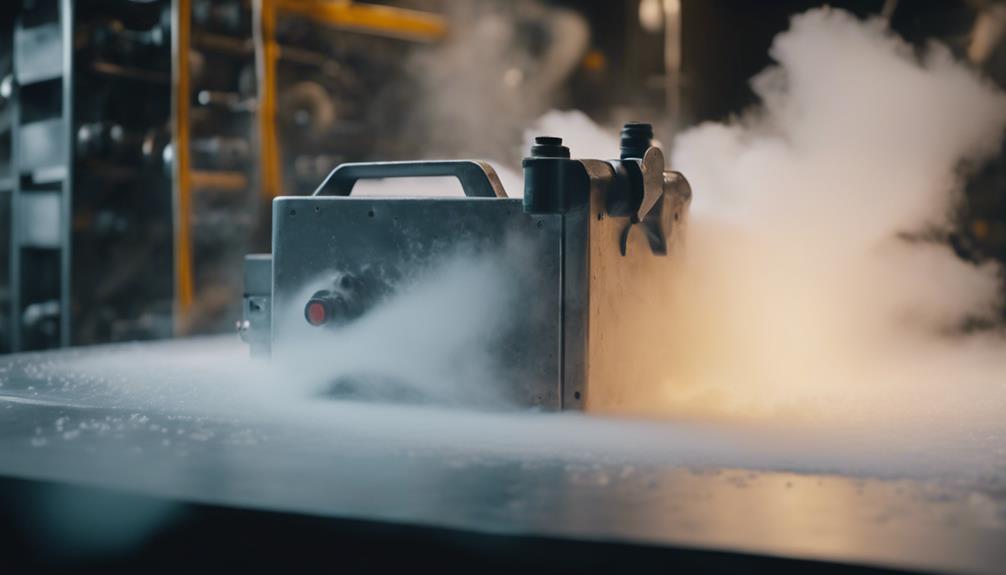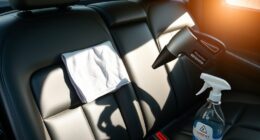To prevent the spread of illness when caring for sick family members, use EPA-registered disinfectants like bleach or quaternary ammonium solutions to thoroughly clean surfaces and fabrics. Wear gloves when handling contaminated laundry, wash items in hot water with disinfectant, and dry on high heat. Regularly disinfect high-touch surfaces and wash your hands afterward. Staying diligent with these cleaning habits helps keep your home safe and healthy—more tips await to ensure you’re fully protected.
Key Takeaways
- Use EPA-registered disinfectants containing sodium hypochlorite or quaternary ammonium compounds to effectively kill germs.
- Wear gloves and wash contaminated laundry separately in hot water with added disinfectant or bleach.
- Regularly disinfect high-touch surfaces like doorknobs, switches, and remote controls to prevent cross-contamination.
- Practice thorough handwashing and maintain good personal hygiene after cleaning or handling contaminated items.
- Ensure proper ventilation during cleaning and dry fabrics completely on high heat to eliminate lingering pathogens.

When a family member is sick, cleaning up afterward can feel overwhelming, but taking the right steps makes it manageable. The key is to focus on disinfectant choices that effectively kill germs without risking your safety or the safety of your laundry. Start by selecting disinfectants proven to eliminate common viruses and bacteria, such as those containing EPA-registered ingredients like sodium hypochlorite (bleach) or quaternary ammonium compounds. Always read labels carefully, and follow instructions precisely—using the right amount and contact time is vital for disinfecting surfaces properly. This reduces the chance of lingering germs and minimizes the spread of illness to other areas of your home.
When it comes to laundry safety, it’s vital to treat contaminated clothing, bedding, and towels with care. Wear gloves when handling soiled items, and wash them separately from other laundry to prevent cross-contamination. Use hot water settings whenever possible, as higher temperatures are more effective at killing viruses and bacteria. Add an appropriate amount of disinfectant or bleach to the wash cycle, and consider running an extra rinse to ensure all germs are removed. Dry items thoroughly on high heat, which further helps eliminate any remaining pathogens. Proper laundry hygiene is essential for maintaining a sanitary environment and reducing the risk of re-infection. These habits keep your laundry sanitary and reduce the risk of re-infection.
Cleaning surfaces should be your next priority. Use disinfectants that are suitable for the specific surfaces you’re cleaning—wood, plastic, or fabric all have different requirements. Keep cleaning tools dedicated to sick-room areas to avoid spreading germs to other parts of your home. Regularly disinfect high-touch areas like doorknobs, light switches, remote controls, and bathroom fixtures, especially after each use or spill. It’s also wise to wash bedding, pillowcases, and towels frequently, as these items can harbor viruses from respiratory secretions or bodily fluids. Remember, always wash contaminated fabrics separately and use the hottest water possible, combined with disinfectant, for maximum safety.
Finally, don’t forget personal hygiene. Wash your hands thoroughly with soap and water after cleaning and handling contaminated items. Maintain good ventilation in the cleaning area to disperse airborne germs and reduce your exposure. By making thoughtful disinfectant choices and practicing laundry safety, you can protect your family and prevent the spread of illness. Staying consistent with these steps simplifies what seems like an overwhelming task and keeps your home healthier for everyone.
Frequently Asked Questions
Can I Reuse Cleaning Cloths After Disinfecting?
You shouldn’t reuse cleaning cloths after disinfecting without proper laundry sanitization. Cleaning cloths can harbor germs, so washing them in hot water with detergent and a disinfectant guarantees they’re sanitized and safe for reuse. This reduces the risk of spreading illness. Always rinse thoroughly and dry completely before using the cloth again. Proper laundry sanitization is key to keeping your environment clean and preventing the spread of germs.
How Often Should I Disinfect High-Touch Surfaces?
You should sanitize high-touch surfaces daily, especially if someone in your family is sick. Regular cleaning reduces the risk of spreading germs, so incorporate cleaning frequency into your routine. Always practice good hand hygiene before and after disinfecting surfaces, and ensure you use effective disinfectants. This combination helps keep your home safe and minimizes illness transmission. Consistency is key to maintaining a healthy environment for everyone.
Is It Necessary to Wear Gloves and Masks During Cleanup?
Think of protective gear as your shield in a battle against cross-contamination. Wearing gloves and masks during cleanup is often necessary, especially if you’re handling bodily fluids or contaminated surfaces. These items help prevent the spread of germs and keep you safe. While not always mandatory, using protective gear adds a vital layer of defense, ensuring you don’t unwittingly carry illness from one surface to another.
How Do I Safely Dispose of Contaminated Tissues and Wipes?
To safely dispose of contaminated tissues and wipes, follow proper disposal procedures. First, place used items in a sealed plastic bag to contain germs. Then, discard the bag in your outdoor trash or a designated waste bin. Always handle contaminated items carefully, avoiding direct contact. Wash your hands thoroughly afterward, even if you wore gloves, to prevent the spread of illness. Proper disposal keeps your home safe and clean.
What Natural Disinfectants Are Effective Against Viruses?
Think of natural disinfectants like a superhero’s secret weapon—powerful yet gentle. You can use essential oils like tea tree or eucalyptus, which have antiviral properties, or vinegar solutions that disrupt virus particles. In my experience, mixing vinegar with water creates an effective, eco-friendly cleaner. These options are safe, affordable, and help prevent the spread of illness, making your home healthier without harsh chemicals.
Conclusion
Remember, a clean home is a healthy home. By promptly disinfecting surfaces, washing linens thoroughly, and practicing good hand hygiene, you can prevent the spread of illness to everyone in your family. Don’t forget, an ounce of prevention is worth a pound of cure. Staying vigilant now means fewer setbacks later. Take these simple steps, and you’ll create a safer, healthier environment for your loved ones—because cleanliness truly is next to godliness.










